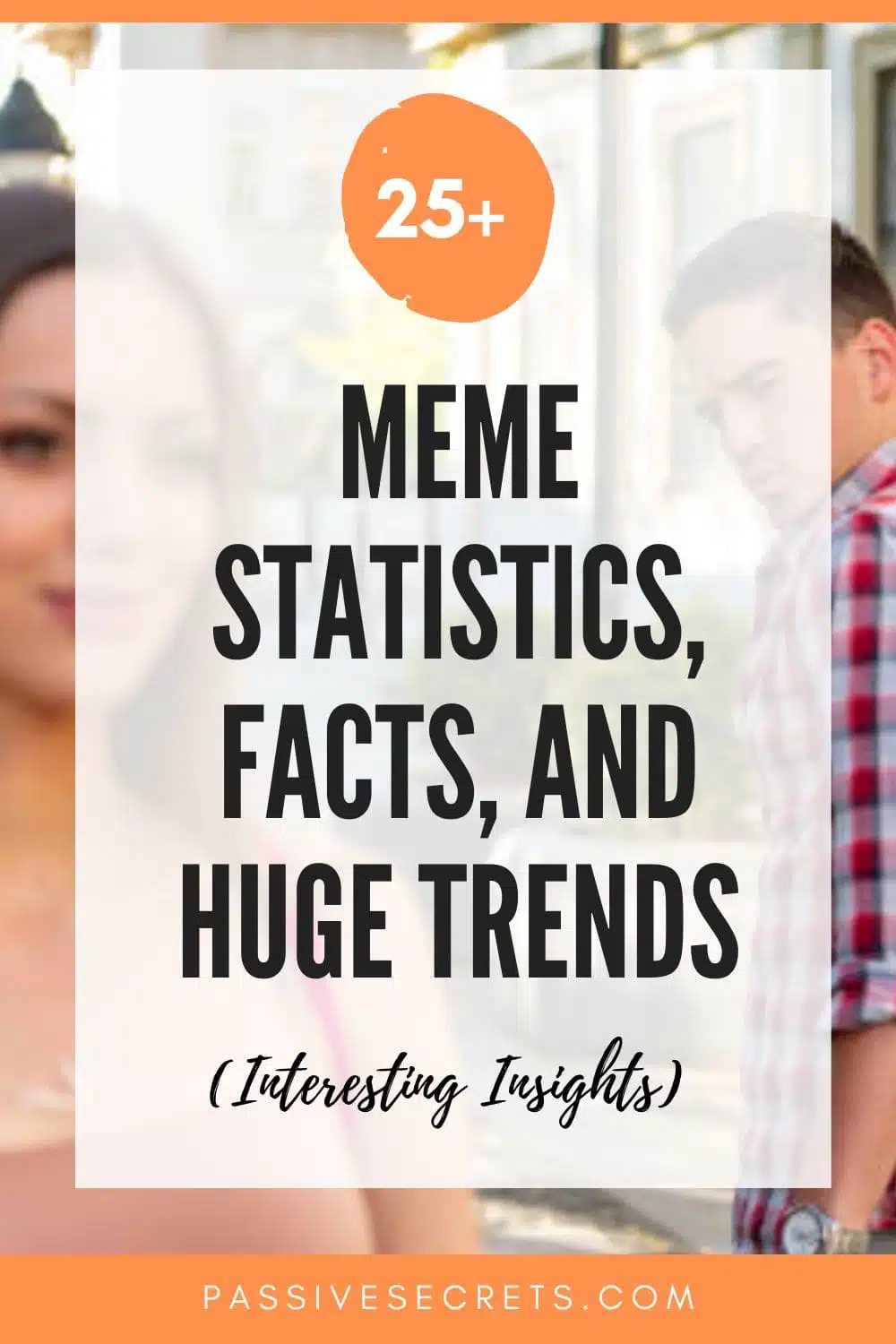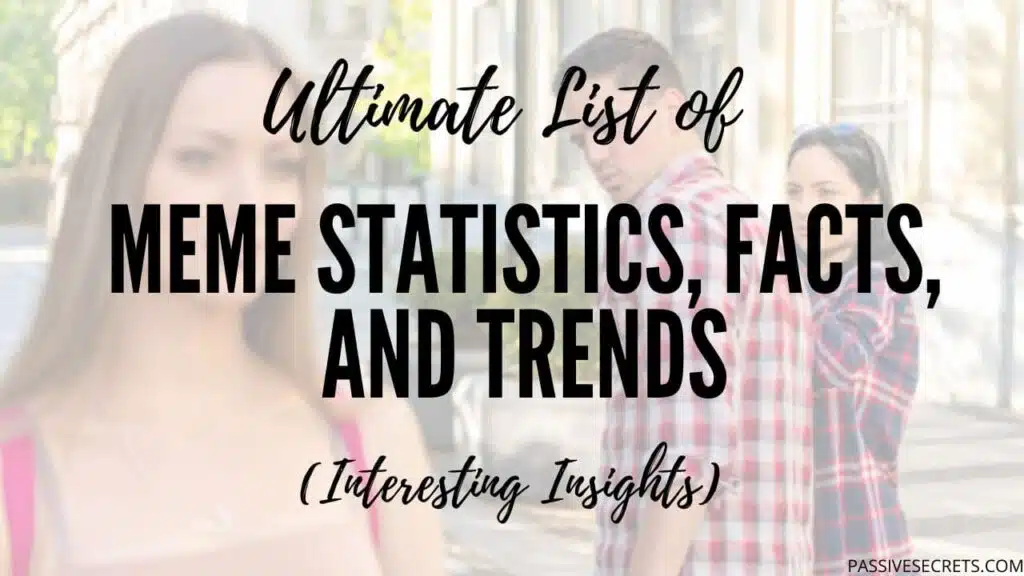
If you are consistent with social media, there’s a huge chance you just saw a meme before coming across this article.
Although memes have existed for decades, they only recently became very popular online.
Ever wondered just how many times that cat video has been shared? Or which meme is the reigning champ of the internet this week?
Memes have become integral to our digital lives, evolving from simple viral images with clever captions to a universal language connecting people worldwide.
Meme statistics offer a glimpse into the demographics of those who create and engage with these digital masterpieces.
From tech-savvy millennials to surprisingly meme-savvy baby boomers, the world of memes is a melting pot of diverse perspectives and experiences.
I bring to you the wild world of meme statistics!
Get ready for a rollercoaster ride through the data jungle of internet humour!
Key Meme Statistics (Editor’s Pick)
- Memes reach ten times more people than traditional marketing visuals and boast a 60% higher organic engagement rate.
- YPulse’s latest social media behaviour survey reveals that 75% of individuals aged 13-36 (and 79% of those aged 13-17) share memes.
- 38% of people follow meme accounts on social media.
- Millennials typically view 20 to 30 memes per day on average.
- The global meme industry was valued at $2.3 billion in 2020 and is expected to grow to $6.1 billion by 2025, with an annual growth rate of 21.6%.
- The most profitable meme NFT is “Disaster Girl,” which sold for over $573,000 at an auction.
- “Yepp” provides an in-app studio for meme creation and shares 50% of its advertising revenue with users.
- Instagram reported that in 2020, users shared one million memes daily, an increase from 500,000 in 2018, indicating a rise in meme popularity.
- GameStop’s stock price surged dramatically due to a meme stock rally driven by social media activity.
- Image macros are the most well-known type of meme, although other forms include videos, GIFs, and text-only memes.
Interesting Meme Facts
Before we get right into the statistics, here are some interesting meme facts you should know:
- There’s a term “meme coin” that is used to refer to cryptocurrencies named after characters, individuals, animals, artwork, and other viral trends. (source)
- Memes used in advertising are expected to grow as companies seek new methods to engage younger audiences. (source)
- Richard Dawkins, an evolutionary biologist, introduced the term “meme” in his 1976 book “The Selfish Gene,” comparing cultural elements that spread among people to genes. (source)
- Memes that elicited stronger emotional reactions were more likely to be shared. Additionally, people were more inclined to share humorous videos over those that were cute, disgusting, or anger-inducing. (source)
- Reese Witherspoon’s 2020 Challenge was a viral pandemic meme that portrayed the year in a relatable calendar format. This inspired similar versions featuring other celebrities like Mindy Kaling and Oprah Winfrey. (source)
- Research during the 2020 lockdown in Spain by Professor Lucía-Pilar Cancelas-Ouviña found humour was a key feature of memes shared on WhatsApp. (source)
- A recent small study revealed that individuals with depression found depression-related memes to be more humorous, relatable, and shareable. (source)
- Memes known as Caća se vrača, depicting former Croatian prime minister Ino Sanadar as a problem-solver after his release from prison, influenced media coverage of him to become more positive. (source)
General Meme Statistics
1. Researchers at New York University discovered that memes reach ten times more people than traditional marketing visuals and boast a 60% higher organic engagement rate. (source)
2. According to the 2023 meme statistics report, the global meme industry was valued at $2.3 billion in 2020 and is expected to grow to $6.1 billion by 2025. With an annual growth rate of 21.6%. (source)
3. Meme campaigns have a click-through rate (CTR) that is 14% higher than email marketing. (source)
4. More than 60% of people claim they are more inclined to purchase from a company that incorporates memes into their marketing. (source)
5. Social media behaviour survey indicates that social media is the preferred platform for sharing memes: 29% share them on social media, 15% via chat apps, and 31% in both places. (source)
6. Significantly, 36% of people send memes to convey their feelings, 35% use them as a code for those who will understand, and 28% use them when words fail to express their emotions. (source)
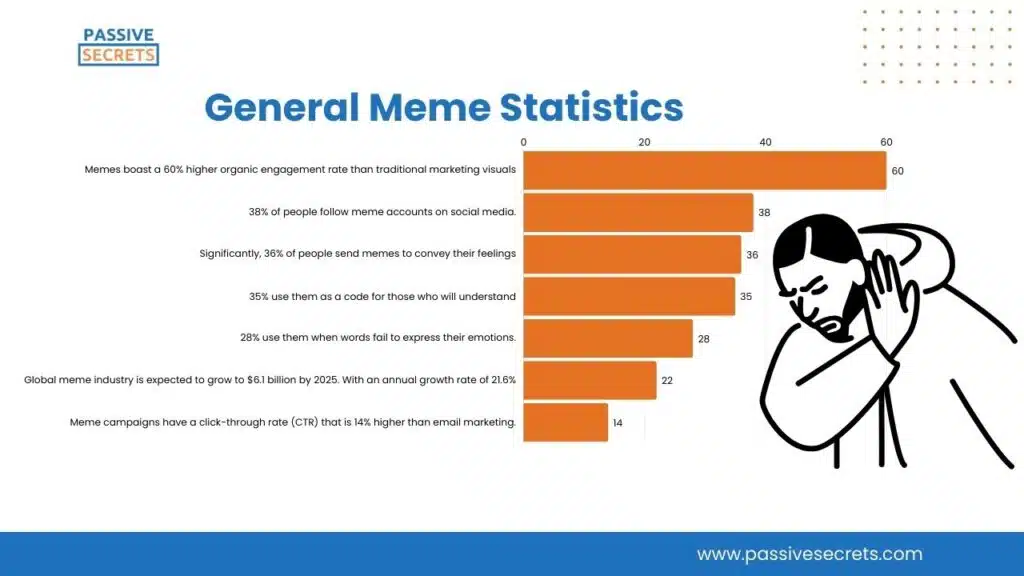
7. 38% of people follow meme accounts on social media. (source)
8. F**ckjerry holds the title of the most-followed meme account on Instagram, boasting 17 million followers. (source)
9. Millennials typically view 20 to 30 memes per day on average. (source)
10. To date, the most profitable meme NFT is “Disaster Girl,” which sold for over $573,000 at auction. The image features a mischievous girl smiling in front of a burning house. The Nyan Cat meme is the second most profitable meme NFT, selling at over $515,000. (source)
11. “Yepp” provides an in-app studio for meme creation and shares 50% of its advertising revenue with users. (source)
12. Instagram reported that in 2020, users shared one million memes daily, an increase from 500,000 in 2018, indicating a rise in meme popularity. (source)
13. As of 2023, the average lifespan of a modern meme is approximately four months (4.017). (source)
14. According to a March 2020 survey by GlobalWebIndex, nearly one-third of internet users in the US and UK viewed a meme on the survey day. That number rose to 54% for those aged 16 to 23. (source)
15. GameStop’s stock price surged dramatically due to a meme stock rally driven by social media activity. (source)
16. Both the Mumbai Police and Tinder India utilize meme marketing. The Mumbai Police Department employs it for public awareness campaigns, while Tinder India uses it to engage users and debunk common relationship myths. (source)
17. Baby Yoda has been mentioned 1.4 million times, surpassing other popular entertainment titles on Instagram. (source)
18. The viral meme of Bernie Sanders wearing mittens raised $1.8 million for charity. (source)
19. In 2015, female scientists used the hashtag #distractinglysexy to share ironic memes of themselves in lab attire. The hashtag garnered over 10,000 posts on social media within a few hours. (source)
20. 30 political memes in the form of videos or GIFs, mostly created by citizens, garnered over 45 million views during the 2017 UK General Election. (source)
21. Another study in Uganda found that political memes were an effective form of political participation among millennials. This suggests that increased exposure to memes correlated with higher participation rates. (source)
22. Image macros, which pair a humorous or thought-provoking image with text, are the most well-known type of meme, although other forms include videos, GIFs, and text-only memes. (source)
23. Burger King and Wendy’s have realized the advertising potential of memes and use them to attract younger customers. Similarly, Netflix and Amazon use memes to promote their products and services. (source)
24. Brands like Tesco leverage memes to engage with their online community, generating significant attention and media value. Tesco’s TikTok campaign, which encouraged users to create their checkout till voiceovers, received 45 million views and £1 million in media value, plus national PR coverage. (source)
Meme Statistics by Demographics
25. YPulse’s latest social media behaviour survey reveals that 75% of individuals aged 13-36 (and 79% of those aged 13-17) share memes. (source)
26. 55% of people aged 13-35 send memes weekly, with 30% sending them daily. (source)

27. Teens are particularly likely to follow meme accounts: 43% of 13-17-year-olds and 56% of 18-20-year-olds report doing so. (source)
28. A Visual Objects poll found that 44% of internet users aged 18 to 34 regularly share memes online. (source)
Latest Meme Trends to Look Out For in 2024 and Beyond
1. Balancing Humor and Professionalism
Brands are balancing being funny and professional to avoid appearing try-hard or insensitive.
On the one hand, memes are often humorous and lighthearted, and brands want to use them to show their playful side and connect with their audience on a more personal level.
However, brands must also maintain professionalism and avoid appearing immature or insensitive.
This means you need to know your audience. Understand what type of humour resonates with their target audience.
Also, use memes in a way that feels true to your brand voice and tone.
Don’t rely too heavily on memes; they can come across as try-hard or unprofessional.
2. Using Memes to Promote New Releases
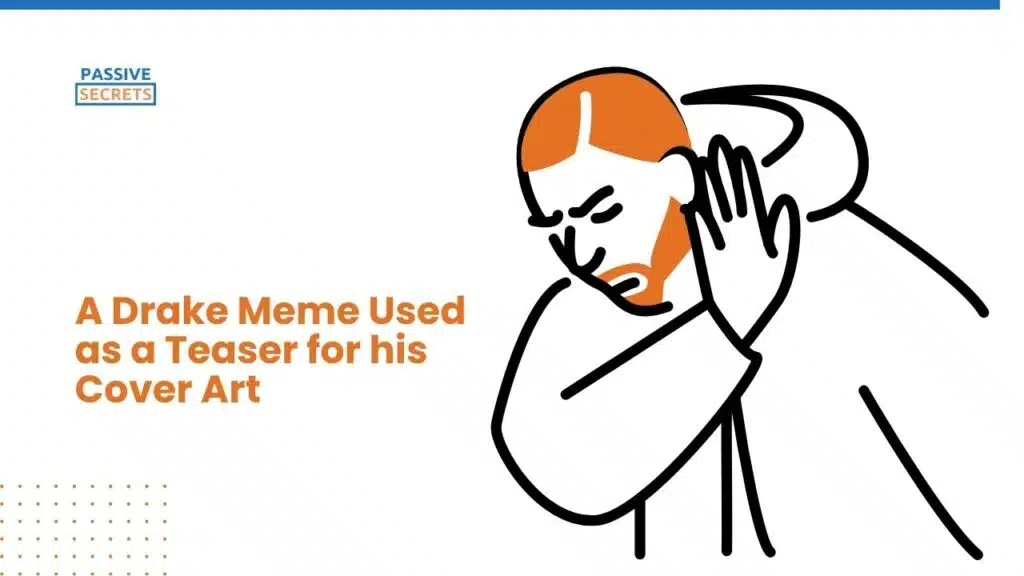
Brands use memes to generate buzz around new products, services, or announcements.
As memes are dominating and getting more popular, brands are using memes to build anticipation and hype around new releases, often by poking fun at the anticipation itself.
Memes showcase key features or benefits of the new release humorously and engagingly. They also interact with the audience, ask for feedback, and encourage sharing and participation.
Brands use memes to create a sense of urgency and exclusivity around new releases, encouraging customers to try them out before they miss out.
3. Using Memes to Promote Brand Relevance
Brands use memes to stay relevant and show their audience that they know current trends and cultural shifts.
As content preferences evolve, brands use memes to demonstrate their cultural relevance and finger on the pulse.
By embracing memes, brands showcase their ability to adapt and evolve, connecting with their audience on a deeper level. This approach builds trust and credibility and positions the brand as modern and in tune with the times.
Through memes, brands can comment on current events, industry news, and societal shifts, highlighting their values and mission humorously and relatable.
By partnering with meme creators and influencers, brands can stay ahead of the curve and ensure their message resonates with a wider audience.
In essence, memes have become a powerful tool for brands to showcase their relevance, build connections, and ultimately drive business results.
4. Popular Culture
In the meme industry, many meme coins are inspired by current trends and pop culture.
Inspired by the latest trends, movies, TV shows, music, and internet sensations, these digital tokens ride the waves of familiarity and fandom.
By embracing the trend, meme coins aim to resonate with a wider audience, leveraging the collective excitement and nostalgia surrounding beloved cultural icons.
Meme coins are not just digital assets but also cultural ambassadors, bridging the gap between technology and entertainment.
As the internet continues to shape and reflect our culture, meme coins are poised to remain at the forefront of this creative and ever-evolving intersection.
Conclusion
Memes have become such a huge part of our online lives these days. They’re everywhere – on social media, in ads, even in political discourse.
And when you look at the numbers, it’s easy to see why. Over 60% of people say they’re more likely to support a brand that uses memes in their marketing.
That’s a huge chunk of potential customers that companies can’t afford to ignore.
But memes aren’t just about business. They’ve become their language, a way for people of all ages to connect and communicate online.
Seeing that perfect meme that sums up exactly how you feel is like finding a kindred spirit in the digital void.
Memes make the internet feel smaller and more human.
So, while they may just seem like silly pictures with words, memes are a powerful force shaping our digital culture.
The numbers don’t lie – memes are here to stay.
Frequently Asked Questions
-
How Big is the Meme Industry?
The global meme industry was valued at $2.3 billion in 2020 and is expected to grow to $6.1 billion by 2025. With an annual growth rate of 21.6%.
-
Who Created Memes?
Richard Dawkins coined the word meme in his 1976 book The Selfish Gene to explain how aspects of culture replicate, mutate, and evolve.
-
What is the Popularity of Memes?
According to HubSpot, 90% of today’s social media feeds contain memes, a trend that is unlikely to change anytime soon.
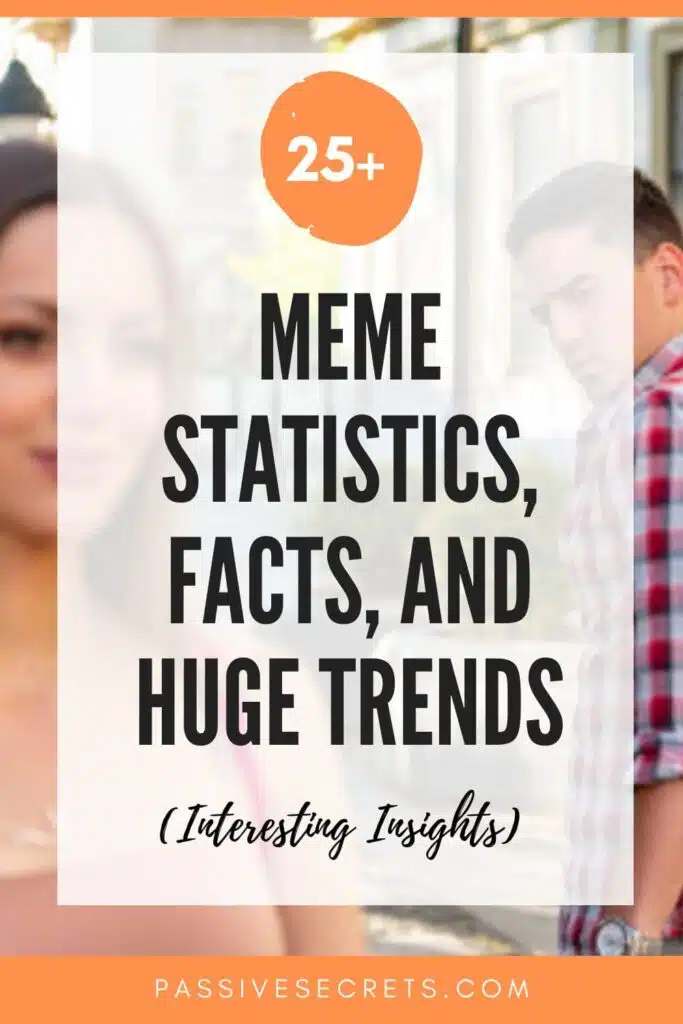
Related Posts:
- Thought-Provoking Gender Inequality Statistics: 160+ Insights Across Regions
- 110+ Shocking Income Inequality Data You Need to Know
- 50 Interesting Sharing Economy Statistics You Need to Know
- 100+ Animation Statistics: The Ultimate Guide To The Industry’s Trends and Insights
- 80+ Franchise Statistics and Facts You Should Know In 2024
- The Future of Learning: 50+ Top EdTech Statistics For 2024
- The Web3 Statistics Report 2024: Trends, Insights, and Predictions
- 85+ MOST Interesting Anime Statistics and Facts (NEW Report)
- Board Game Statistics: Revenue, Market Size, Demographics & More
- 125+ Interesting Airbnb Statistics by Country (Deep Insights)
- 50+ Interesting Born Into Poverty Stay In Poverty Statistics
- 90+ Interesting Film Industry Statistics (NEW Report)
- 80+ Alarming Technology Addiction Statistics You Must Know
- 65+ Impressive Chess Statistics and Facts To Know in 2024
- Spotify Statistics: Latest Report on The Music Streaming Platform
- 50+ Useful Video Game Addiction Statistics, Facts & Huge Trends
- 50+ Vital Internet Safety Statistics & Facts You Must Know
- Internet Dangers Statistics: A Look At The Internet’s Dark Side
- 50 Interesting Bible Statistics and Facts You Didn’t Know
- 95+ Interesting Dream Statistics and Facts You Can’t Miss
- 75+ Interesting Relationship Statistics & Facts You Should Know
- Dance Statistics: A Deep Dive Into The Rhythm Of Movement
- 40+ Incredible Single Father Statistics You Have to Know
- The Battle of the Sexes: Male Vs. Female Spending Statistics
- 95+ Jaw-Dropping Period Poverty Statistics You Need To Know
- 70 Exciting Love Statistics And Facts (True Love, Intimacy, Marriage, Dating & Relationships)
- 30+ Gentle Parenting Statistics & Facts: Is This Parenting Style Worth It?
- 55+ Useful Black Consumer Spending Statistics (2024 Report)
- Holiday Spending Statistics: Valentine’s Day, Easter, Thanksgiving, & Christmas

